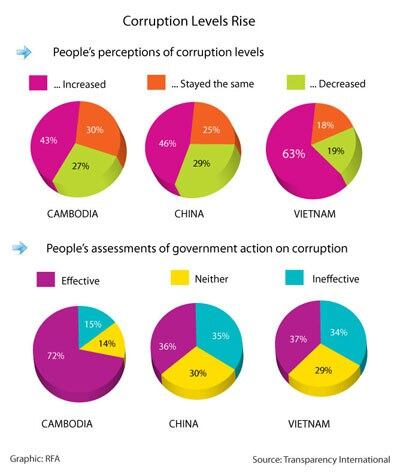Corruption levels have increased in China, Cambodia, and Vietnam over the last three years, according to a new report by Transparency International.
Asked if the level of corruption has changed, a majority of "ordinary people" surveyed in the three countries said it had increased, the Berlin-based monitoring group said in a report, the 2010 Global Corruption Barometer.
In Cambodia, 43 percent of the people polled said corruption had increased, and 30 percent felt it had decreased, while 27 percent believed it was around the same.
A total of 46 percent in China said graft had increased, and 25 percent said it had decreased, while 29 percent felt the situation had not changed.
In Vietnam, a higher number of people, 63 percent, said corruption levels had increased, while 18 percent felt they had dropped and 18 percent believed the situation had remained the same.
Cambodia's judiciary was found to be the most corrupt sector in that country, while in China, it was the business sector, according to the survey.
In Vietnam, the police force was identified as the most graft-ridden.
Efforts assessed

Respondents were also asked to assess their government’s actions in the battle against corruption. In Cambodia, 72 percent felt these efforts were effective, while in China, it was 36 percent and in Vietnam 37 percent.
Transparency International said six out of 10 people around the world felt graft levels had surged.
One in four people reported paying bribes in the last year.
“This global barometer is based on the opinions of ordinary people in different countries,” said Liao Ran, an Asia program officer for Transparency International.
In China, Cambodia, and Vietnam, public perceptions of corruption focused on different social sectors, Liao said.
“In Cambodia, [responses] highlighted corruption in the judicial sector, while in China they focused on the business sector.”
In Vietnam, respondents were more concerned about corruption among the police, Liao said.
Liao added that despite concerns about corruption in the courts, Cambodians are now “more hopeful” about the level of corruption in the country overall.
A clear majority in Cambodia also agreed that government anti-corruption efforts have been effective, noted Samantha Grant, a Transparency International program officer for Southeast Asia.
More evenly divided responses were reported in China and Vietnam, Grant said.
'Mixed results'
Grant said there has been “a definite push” by Vietnam’s government over the last few years to develop a national anti-corruption strategy.
“But these efforts aren’t being seen as having quite the impact that they could have. So I think that’s why we’re seeing mixed results there.”
The 2010 Barometer captured the perceptions of more than 91,500 people in 86 countries and territories, reputedly the only worldwide public opinion survey on corruption.
The survey also found that seven out of 10 people would be willing to report an incident of corruption, the group said.
Sub-Saharan Africans reported paying the most bribes, with more than one in two people reporting having paid a bribe in the past 12 months.
This compares to 36 per cent of people surveyed in the Middle East and North Africa, 23 per cent in Latin America, and 11 per cent in Asia Pacific.
More than 20 countries reported significantly more petty bribery than in 2006, when the same question was asked in the Barometer.
Cambodia was among a list of countries with the biggest number of reported bribery payments in 2010 and where more than 50 per cent of people surveyed had paid a bribe in the past 12 months.
Half the people questioned said their government’s efforts to stop corruption were ineffective, Transparency International said. Opinions had worsened slightly since 2007 in the Asia Pacific region.
"The message from the 2010 Barometer is that corruption is insidious. It makes people lose faith," said Huguette Labelle, head of Transparency International.
“The good news is that people are ready to act. Better whistleblower protection and greater access to information are crucial."
Reported in Washington by Richard Finney and Parameswaran Ponnudurai.
